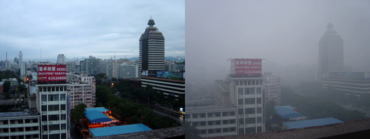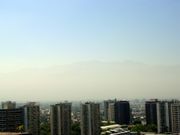Smog
2007 Schools Wikipedia Selection. Related subjects: Environment

Smog is a kind of air pollution; the word "smog" is a portmanteau of smoke and fog. Classic smog results from large amounts of coal burning in an area and is caused by a mixture of smoke and sulphur dioxide.
Photochemical smog
In the 1950s a new type of smog, known as photochemical smog, was first described. This is a noxious mixture of air pollutants including the following:
- nitrogen oxides, such as nitrogen dioxide
- tropospheric ozone
- volatile organic compounds (VOCs)
- peroxyacyl nitrates (PAN)
- aldehydes (R'O)
All of these chemicals are usually highly reactive and oxidizing. Due to this fact, photochemical smog is considered to be a problem of modern industrialization.
Photochemical smog is a concern in most major urban centres but, because it travels with the wind, it can affect sparsely populated areas as well. Smog is caused by a reaction between sunlight and emissions mainly from human activity. Photochemical smog is the chemical reaction of sunlight, nitrogen oxides (NOx) and volatile organic compounds (VOC's) in the atmosphere, which leaves airborne particles (called particulate matter) and ground-level ozone. Nitrogen oxides are released in the exhaust of fossil fuel-burning engines in cars, trucks, coal power plants, and industrial manufacturing factories. VOC's are vapors released from anthropogenic (man-made) sources such as gasoline, paints, solvents, pesticides, and biogenic sources, such as pine and citrus tree emissions.
Origin of term
The term "smog" was first coined by Dr. Henry Antoine Des Voeux in his 1905 paper, “Fog and Smoke,” for a meeting of the Public Health Congress. The 26 July 1905 edition of the London newspaper Daily Graphic quoted Des Voeux, “[H]e said it required no science to see that there was something produced in great cities which was not found in the country, and that was smoky fog, or what was known as ‘smog.’” The following day the newspaper stated that “Dr. Des Voeux did a public service in coining a new word for the London fog.”
Areas affected

Smog can form in almost any climate where industries or cities release large amounts of air pollution. However, it is worse during periods of warmer, sunnier weather when the upper air is warm enough to inhibit vertical circulation. It is especially prevalent in geologic basins encircled by hills or mountains. It often stays for an extended period of time over densely populated cities or urban areas, such as London, New York, Los Angeles, Mexico City, Houston, Toronto, Athens, Beijing, Hong Kong, the Randstad or Ruhr Area and can build up to dangerous levels.
London
London has been known for smog since Roman times. In 1273, concerns over air pollution were sufficient for Edward I to (briefly) ban coal fires in London. In 1661, John Evelyn's Fumifugium suggested burning fragrant wood instead of mineral coal, which he believed would reduce coughing. The Ballad of Gresham College the same year describes how the smoke "does our lungs and spirits choke, Our hanging spoil, and rust our iron."
Severe episodes of smog continued in the 19th century and were nicknamed "pea-soupers". The Great Smog of 1952 darkened the streets of London and killed approximately 4,000 people in the short term (a further 8,000 died from its effects in the following weeks and months). Initially a flu epidemic was blamed for the loss of life. In 1956 the Clean Air Act introduced smokeless zones in the capital. Consequently, reduced sulphur dioxide levels made the intense and persistent London smog a thing of the past. It was after this the great clean-up of London began and buildings recovered their original stone façades which, during two centuries, had gradually blackened. Smog caused by traffic pollution, however, does occur in modern London.
Mexico City
Due to its location in a highland 'bowl', cold air sinks down onto the urban area of Mexico City, trapping industrial and vehicle pollution underneath, and turning it into the most infamous smog-plagued city of Latin America. Within one generation, the city has changed from being known for some of the cleanest air of the world into one with some of the worst pollution, with pollutants like nitrogen dioxide breaching international health standards by 2-3 times.
Tehran
In December 2005, schools and public offices had to close in Tehran, Iran and 1600 people were taken to hospital, in a severe smog blamed largely on unfiltered car exhaust.
Health effects
Smog is a problem in a number of cities and continues to harm human health. Ground-level ozone is especially harmful for senior citizens, children, and people with heart and lung conditions such as emphysema, bronchitis, and asthma. It can inflame breathing passages, decreasing the lungs' working capacity, and causing shortness of breath, pain when inhaling deeply, wheezing, and coughing. It can cause eye and nose irritation and it dries out the protective membranes of the nose and throat and interferes with the body's ability to fight infection, increasing susceptibility to illness. Hospital admissions and respiratory deaths often increase during periods when ozone levels are high .
The U.S. EPA has developed an Air Quality index to help explain air pollution levels to the general public. 8 hour average ozone concentrations of 85 to 104 ppbv are described as "Unhealthy for Sensitive Groups", 105 ppbv to 124 ppbv as "unhealthy" and 125 ppb to 404 ppb as "very unhealthy" . The "very unhealthy" range for some other pollutants are: 355 μg m-3 - 424 μg m-3 for PM10; 15.5 ppbv - 30.4ppb for CO and 0.65 ppbv - 1.24

Natural causes
An erupting volcano can also emit high levels of sulphur dioxide, creating volcanic smog, or vog.
The burning of forests in Indonesia has on a number of occasions created prolonged smog-like haze, which have extended to parts of Malaysia, Philippines, Singapore and Thailand although a lot of the times these fires are started by farmers who want to clear away land for the start of the new planting season.

